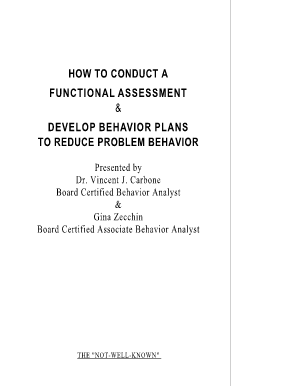
Get How To Conduct A Functional Assessment And Develop Behavior Plans To Reduce Problem Behavior By 2020-2025
How it works
-
Open form follow the instructions
-
Easily sign the form with your finger
-
Send filled & signed form or save
How to use or fill out the How To Conduct A Functional Assessment And Develop Behavior Plans To Reduce Problem Behavior By online
Filling out the How To Conduct A Functional Assessment And Develop Behavior Plans To Reduce Problem Behavior By form online is a critical process for anyone looking to effectively assess and plan interventions for problematic behaviors. This guide provides clear, step-by-step instructions tailored to users of all experience levels.
Follow the steps to successfully complete the functional assessment form online.
- Press the ‘Get Form’ button to access the form. This will allow you to open it in your preferred online editor.
- Begin by filling in the ‘Student Information’ section. Input the student's name, ID number, and date of assessment. Ensure accuracy as this information is vital for tracking progress.
- In the ‘Behavior of Concern’ section, describe the specific behaviors that you are addressing. Be concise and objective.
- Proceed to the ‘Setting Event’ section. Note any factors or events that appear to trigger the behavior. Look for patterns or specific situations where the behavior is more likely to occur.
- Next, fill out the ‘Antecedents’ section to identify what often happens right before the behavior occurs. This will help in understanding the triggers.
- In the ‘Consequences’ section, document the outcomes following the behavior. This will provide insights into what the individual gains from the behavior.
- Analyze the ‘Maintaining Variables’ outlined in the form, classifying the identified behavioral functions such as gaining attention or escape from demands.
- Complete the ‘Replacement Behaviors’ section where you will suggest alternative, appropriate behaviors that can replace the problematic ones.
- In the final sections, provide information about interventions based on the identified functions of the behavior, ensuring all proposed strategies are clear and concise.
- Review all filled sections for accuracy and completeness. Once satisfied, follow the options to save changes, download, print, or share the document.
Start filling out the form online today to effectively assess and plan behavior interventions!
A functional assessment of a problem behavior involves a systematic evaluation aimed at determining the underlying causes and functions of that behavior. This assessment seeks to identify triggers, circumstances, and potential reinforcements that contribute to the problem. By gaining this understanding, you can effectively learn how to conduct a functional assessment and develop behavior plans to reduce problem behavior, leading to enhanced behavioral outcomes.
Industry-leading security and compliance
-
In businnes since 199725+ years providing professional legal documents.
-
Accredited businessGuarantees that a business meets BBB accreditation standards in the US and Canada.
-
Secured by BraintreeValidated Level 1 PCI DSS compliant payment gateway that accepts most major credit and debit card brands from across the globe.


